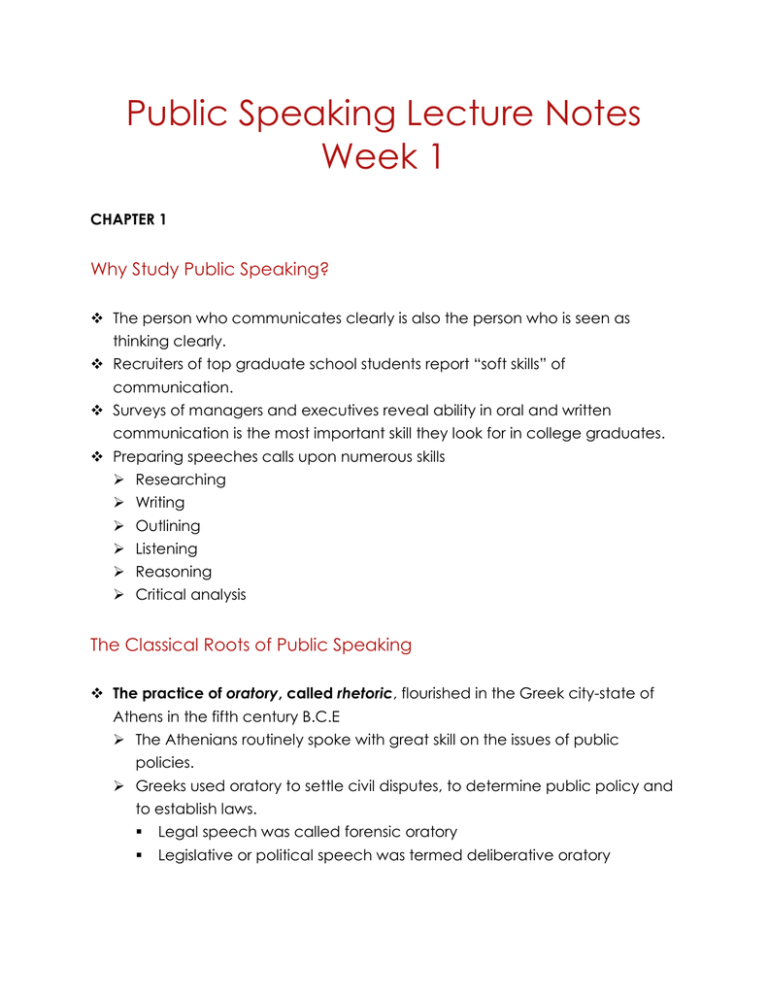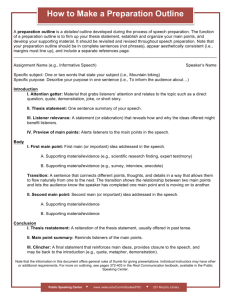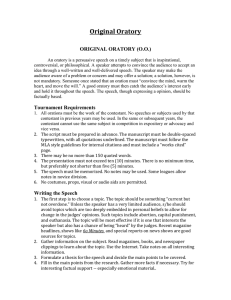File
advertisement

Public Speaking Lecture Notes Week 1 CHAPTER 1 Why Study Public Speaking? The person who communicates clearly is also the person who is seen as thinking clearly. Recruiters of top graduate school students report “soft skills” of communication. Surveys of managers and executives reveal ability in oral and written communication is the most important skill they look for in college graduates. Preparing speeches calls upon numerous skills Researching Writing Outlining Listening Reasoning Critical analysis The Classical Roots of Public Speaking The practice of oratory, called rhetoric, flourished in the Greek city-state of Athens in the fifth century B.C.E The Athenians routinely spoke with great skill on the issues of public policies. Greeks used oratory to settle civil disputes, to determine public policy and to establish laws. Legal speech was called forensic oratory Legislative or political speech was termed deliberative oratory Speeches delivered in ceremonies, such as celebrations or funerals, was called epideictic oratory. Aristotle’s Canons of Rhetoric Invention – refers to adapting speech information to the audience in order to make your case. Arrangement – is organizing the speech in ways that are best suited to the topic and the audience. Style – is the way the speaker uses language to express the speech ideas. Memory – is the practice of the speech until it can be artfully delivered. Delivery - is the vocal and nonverbal behavior you use when speaking. Similarities between Public Speaking and Other Forms of Communication – Interpersonal/Mass /Small Group Communication A key feature of any type of communication is sensitivity to the listeners. Your listeners want to feel that you care about their interests, desires, and goals. Differences between Public Speaking and Other Forms of Communication Several Factors distinguish public speaking from these other forms: Opportunities for feedback Public speaking offers a middle ground between low and high levels of feedback. Level of preparation Preparation / lack of preparation stands out starkly Degree of formality Speeches tend to occur in more formal settings than do other forms of communication. Thus public speaking shares many features of everyday conversation, but because the speaker is the focal point of attention in what is usually a formal setting, listeners expect a more systematic presentation than they do in conversation or small group communication. As such, public speaking requires more preparation and practice than the other forms of communication. Communication Process Source Encoding Receiver Decoding Feedback Message Channel Noise Share meaning (goal of all communication) Audience-centered approach Keeping the needs, values, attitudes, and wants of your audience firmly in focus. Learning to Speak in Public Draw on conversational skills People like to feel as if you are speaking directly to them. Try to uncover the audiences’ interests and needs before speaking Draw on skills in composition Both speaking and writing require you research a topic, offer credible evidence, employ effective transitions to signal the logical flow of ideas, and devise persuasive appeals. Develop an effective oral style Successful speakers generally use familiar words, easy-to-follow sentences, straight-forward syntax (subject-verb-object agreement), and transitional words and phrases. Routinely repeat key words and phrases to emphasize ideas and help listeners follow along. When you give a speech, listeners expect you to speak in a clear, recognizable, and organized fashion. Practice the words you will say and the way you will say them A primary focus is on offering something of value for the audience Become an inclusive speaker Speakers must cultivate their cultural intelligence Cultural Intelligence means being skilled and flexible about understanding a culture, learning more about it from your ongoing interactions with it, and gradually reshaping your thinking to be more sympathetic to the culture and to be more skilled and appropriate when interacting with others from the culture. CHAPTER 2 Overview of the Speechmaking Process See Figure 2.1 Steps in the Speechmaking Process (p 18) Select a topic Be aware, however, that it’s equally important that your topic will be of interest to the audience. Analyze the Audience The process of getting to know your listeners relative to the topic and the speech occasion. Audiences have personalities, interests, and opinions all their own that affect how receptive they will be toward a given topic. It is imperative that you learn as much as you can about the similarities and differences among the members of your audience. Determine the Speech Purpose General speech purposes: To inform/demonstrate To persuade, To mark a special occasion Your speech should have a specific purpose A single phrase stating what you expect the speech to accomplish. Compose a Thesis statement A thesis statement clearly expresses the central idea of your speech. It concisely identifies for your audience, in a single sentence, what the speech is about Wherever you are in the planning state, always refer to the thesis statement to make sure that you are on track to illustrate or prove your thesis. Develop the Main Points Organize your speech around two or three main points. The primary pieces of knowledge (informative speech) Key arguments (persuasive speech) Gather Supporting Material Supporting material illustrates the main points by clarifying, elaborating and verifying the speaker’s ideas. Often this is done by using sources from personal experiences to statistics from out-side sources (More on this in chapter 8-10). Research your topic for supporting material to provide evidence for your assertions and lend creditability to your message. Separate the Speech into its Major Parts Introduction serves to introduce the topic and the speaker, to alert audience members to your specific speech purpose, and to catch the audience’s attention and interest. Making a startling statement, telling a story, or using humor are a few ways to grab the audience’s attention (See chapter 15) Body – the speech’s main points and sub points, all of which support the speech’s thesis. Illustrate or argue each of your main ideas Using supporting material you have gathered to clarify, elaborate or substantiate your points. Conclusion – restates the speech purpose and reiterates how the main points confirm it. Make sure to end on a strong note (see chapter 16). Outline the Speech Coordinate points referred to as main points, are of equal importance Subordinate points the substance of the main points Working outlines contain points stated in complete sentences. Speaking outlines briefer and usually prepared using either short phrases or key words. INTRODUCTION Captures audience attention – in this case, with a startling statement and select dramatic details of her story States thesis statement and previews main points. In a brief speech, the preview can act as a transition. BODY You lay out your argument, story, or the details of the information you are providing. Conclusion Restates the thesis in a memorable way Restate main points and how they support or prove of the thesis statement. Leaves the audience with a motivating message. Presentation Aids Presentation aids can be as simple as writing the definition of a word on a blackboard or manipulating a physical object while describing it or is as involved as a multimedia slide show. Can often help the audience to retain ideas and understand difficult concepts. Preparing to Deliver the Speech Pronunciation – correct formation of word sounds. Articulation – the clarity or forcefulness with which the sounds are made.


